
The role of refrigerants
Refrigerants are the lifeblood of heat pumps. They circulate through the heat pump system, absorbing and releasing heat to facilitate the transfer of thermal energy. Every heat pump uses either chemical or natural refrigerants.
The primary function of refrigerants in heat pumps can be summarised in four stages:
Evaporation: In the ‘outdoor’ unit, the refrigerant absorbs heat from the surrounding air or space, causing the refrigerant to evaporate from a low- pressure liquid into a gas.
Compression: the gaseous refrigerant is then compressed, which increases its temperature and pressure significantly.
Condensation: in the ‘indoor’ unit, the high- temperature, high-pressure refrigerant gas releases heat as it condenses back into a liquid.
Expansion: the liquid refrigerant returns to the outdoor unit, undergoing expansion on the way to reduce its pressure and temperature to be ready to repeat the cycle.
Evolution
Over time, the choice of refrigerants used in heat pumps has evolved, largely due to environmental concerns. Early refrigerants were, most commonly, chlorofluorocarbons (CFCs) such as R12 and were very effective, but by the late 1980s it was discovered that CFCs were depleting the ozone layer and contributing to global warming.
To replace CFCs, hydrochlorofluorocarbons (HCFCs) like R22 were introduced which had significantly less ozone-depleting potential but still had a considerable global warming potential (GWP).
Today, environmentally friendly refrigerants are favoured for their lower impact on the environment.
The main refrigerants in use include:
- R410A and R134a: Hydrofluorocarbon (HFC) refrigerants that have become popular replacements with zero ozone-depletion potential but still high GWP).
- R32: Another HFC refrigerant gaining popularity for its lower GWP. It is considered more environmentally friendly, but it is still an HFC.
- R290 (Propane): R290 is a hydrocarbon refrigerant with a significantly lower GWP than HFCs.
Concerns over Global Warming Potential (GWP)
The GWP of a refrigerant is a measure of how much heat a greenhouse gas traps in the atmosphere over a specific time period (usually 100 years) compared to carbon dioxide (CO2). Higher GWP values indicate greater warming potential. The goal is to use refrigerants with lower GWPs to mitigate climate change.
Impact considerations
The safest refrigerants in heat pumps are those with the lowest GWPs and minimal environmental impact.
Natural refrigerants like carbon dioxide (CO2, R744) and ammonia (R717), and hydrocarbons such as propane (R290) are among the safest options due to their low GWP and minimal ozone depletion potential.
They are gaining attention for their ecological credentials but come with their own challenges such as high working pressures or concerns over flammability.
Cost considerations
The cost of the refrigerants used in heat pumps is influenced by several factors including:
- Type of refrigerant: Natural refrigerants like carbon dioxide (CO2, R744) and hydrocarbons (e.g., propane, R290) are often more affordable than synthetic refrigerants like some hydrofluorocarbons (HFCs) and hydrochlorofluorocarbons (HCFCs).
- Availability: The availability of a specific refrigerant can impact cost, with refrigerants that are widely used and readily available naturally more affordable.
- Regulations: Government regulations and taxes can affect the cost of refrigerants. Some countries and regions have imposed taxes or restrictions on refrigerants with high GWP, which can increase their price.
In the choice of refrigerant for a heat pump system the initial cost of the refrigerant is a consideration, but it is also important to weigh the long-term environmental and efficiency benefits, as well as compliance with regulations.
The shift to propane
ISH, the world’s leading trade fair for HVAC, held in March in Germany confirmed the new focus of the HVAC industry in Europe on offering an alternative to fluorinated gases in residential and commercial heating and cooling sector.
The last 12 months has seen a dramatic shift to the use of R290 and the manufacturers not exhibiting R290 were an absolute minority according to Jan Dusek, COO of ATMOsphere who commented: “We expect R290 air-to-water heat pumps to be deployed to market in the millions of units starting 2024.”
Monobloc systems, usually located outdoors with the refrigerant hermetically sealed in the unit, are considered low-hanging fruit in the transition to natural refrigerants. Included in the European Commissions proposed EU F-gas Regulation is a ban of fluorinated greenhouse gases above GWP 150 in monoblocs from January 2025.
Panasonic launched its R290 heat pump in June and Jose Alves, Regional Director for the UK, Ireland, and the Netherlands, commented: “The Panasonic Aquarea L series of heat pumps introduces the natural refrigerant R290 to Panasonic’s domestic air-to-water heat pump series (with a GWP of only 3). With the introduction of this exciting new unit, Panasonic is driving forward its GREEN IMPACT plan, as well as its vision for a carbon-free society.”
The shift towards environmentally friendly refrigerants with lower GWP values further enhances the low carbon credentials of heat pump systems. As technology continues to advance, we can expect further innovations in refrigerants that balance performance, safety, and environmental responsibility.
